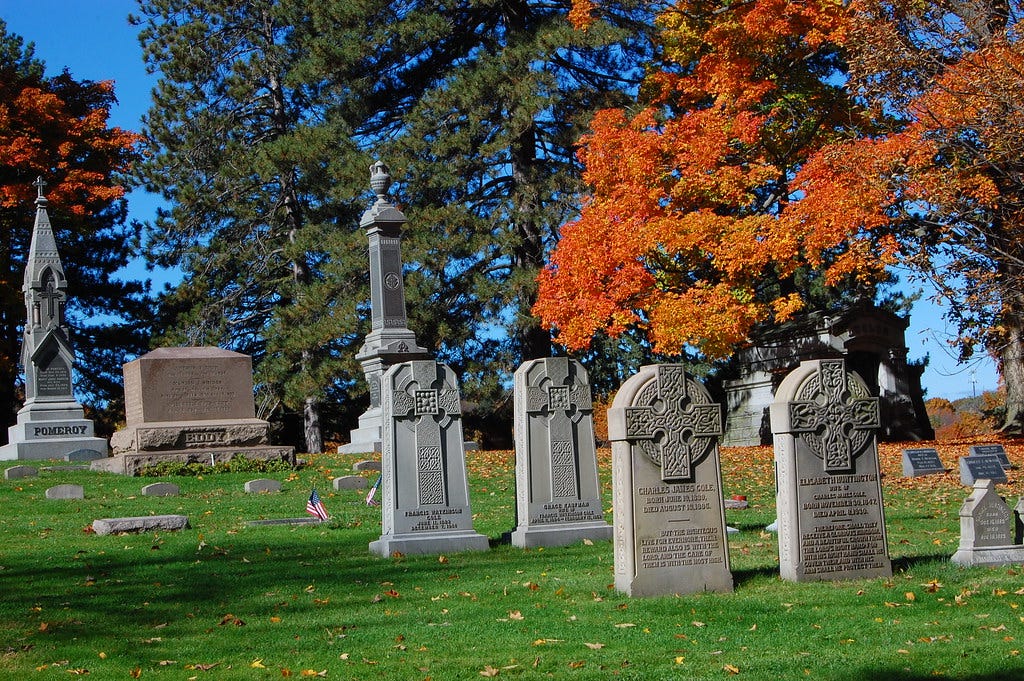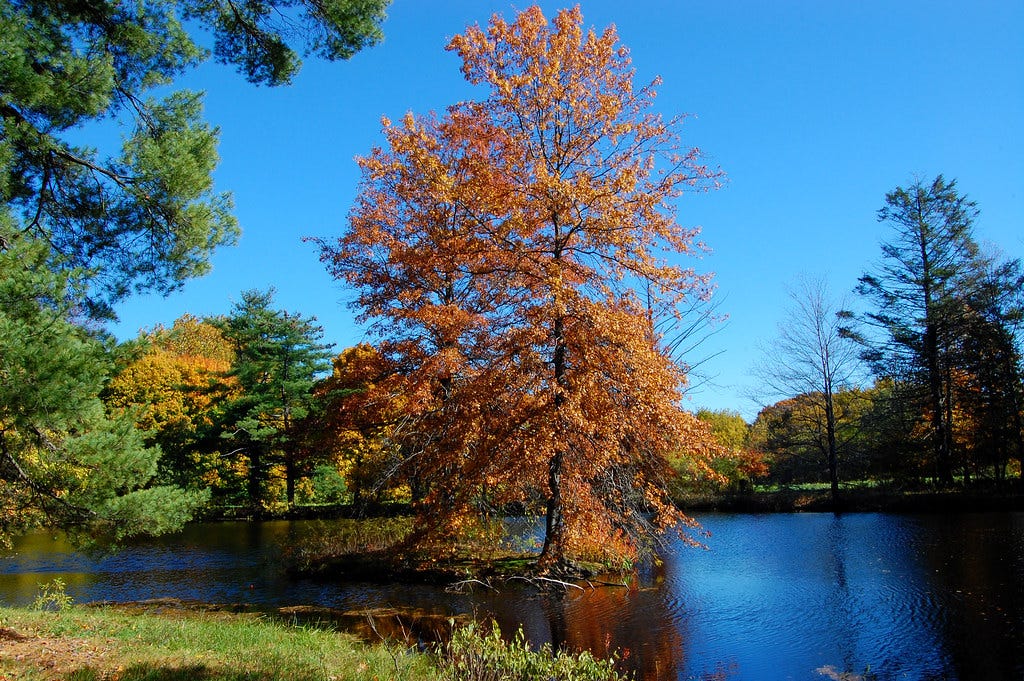Not long before the pandemic, I was sent to Cleveland to write a story about the city’s economic comeback and thriving subculture. And everyone I met, from the tech bros to the bartender who sold me a damn good black IPA, told me that at some point during my 72 hours in town, I had to wander through Lake View Cemetery. So I made my way to the southern gatehouse of the place one muggy morning and spent a solid hour contentedly wandering past the tombs of illustrious Clevelanders such as Eliot Ness and John D. Rockefeller. I tracked down the Haserot Angel, an unnerving statue that appears to be weeping black tears, thanks to the statue’s bronze materials aging and darkening over the decades. Just steps away from here, I watched a family of ducks toying with the idea of a morning swim, on the banks of a little pond. I could have explored for another hour. But alas, I had to go and interview somebody from the chamber of commerce.
My visit to Lake View belongs to a special genre of unusual hiking that can yield one of the most atmospheric and memorable hikes of your life: cemetery hiking. That is to say, embarking on a meandering walk through a burial ground that’s open to the public and replete with interesting scenery and historic features. It would be tough to go for a cemetery *hike* in a cemetery that principally consists of tombstones on a small, exposed plot of grass. But many cemeteries seem built for the living as much as the dead, with wandering paths, groves of shade trees, and water features that would rival the most decadent golf courses. All of this open space allows room for contemplation, memories, and of course, grieving—in solitude or in the company of loved ones. In 2013, one of my closest friends from college passed away from pancreatic cancer. The next year, a few of us climbed the hill on which he was buried, among hundreds, and as we sat by his headstone overlooking Los Angeles in the late afternoon, we wondered if our late friend would have suggested Fatburger or El Cholo for later that night. He always knew where to go.
Whether you’re visiting a cemetery to remember someone you miss—or to simply share that space and atmosphere with those who are—a hike through a cemetery evokes feelings which can be a balm for difficult times. And in New England, one of the most immersive and peaceful burying grounds for a quiet, ruminative hike is Hartford’s Cedar Hill Cemetery. Designed by the Swiss landscape architect Jacob Weidenmann (whose portfolio also includes the Iowa State Capitol grounds and co-credit with Frederick Law Olmsted for Montreal’s Mont Royal Park), the cemetery is spread across 270 acres of lush, chirping ground. The rural aesthetic and layout of Cedar Hill was directly inspired by Mount Auburn Cemetery in Cambridge, Massachusetts. But Hartford’s cemetery upstages the Harvard Square favorite in terms of scale and roamability. At Mount Auburn, more than 100,000 people are buried or commemorated in its 170 acres, while Cedar Hill’s vaster grounds are home to only 30,000 “residents” (including Katherine Hepburn and Samuel Colt). For visitors, this means more open space through which to walk and think.
Understandably, you’re very unlikely to find a codified trail through any cemetery, for the same reason why you won’t find pull-up bars next to a war memorial in the park. But the presence of paths, ponds, and gardens is an invitation to take a foot journey through the cemetery. Cedar Hill offers corridors of forest, wetlands, and fields. The website even vamps up the local wildlife, including white-tail deer, eastern coyotes, and cottontail rabbits. (When I die, I want to be buried or scattered in a place where rabbits can hop around. Don’t ask me why: I just want this.) Plus, the bird population at Cedar Hill is robust enough that each winter, the Audubon Society stages its annual winter bird count here, taking note of all those dark-eyed juncos, American robbins, and woodpeckers. Some of the trees that loom here are actually rare imports, including ginkgo biloba and Chinese witch-hazel, which makes Cedar Hill Cemetery sort of an arboretum too.
But for some visitors, the ultimate natural landmark at Cedar Hill is Lake Llyn Mawr, a celestial body of water near the main entrance drive. The cemetery has actually taken steps to mitigate the overgrowth of water lilies and other plants that can transform a lake into a bog (when these plants decompose, they release enough carbon dioxide to create issues for the flora and fauna that rely on the lake.) Lake Llyn Mawr was spotlit in a 2006 Hartford Courant article which called Cedar Hill Cemetery “a monument to solitude.” Having gone there recently, I’m very inclined to agree.
I think everyone reading this knows a thing or two about the etiquette of visiting a cemetery and sharing a space with people who may be visiting late friends and family members. But since this is a hiking newsletter and “hiking” carries certain aesthetic and recreational conventions, allow me to offer a few suggestions. First, dress for the territory. Save your neon tri-colored Cotopaxi windbreaker for a more conventional hiking venue, and go for something earthier and neutral. Second, since any cemetery hike is more or less improvised, hike where there is open space and keep a good distance from individuals or parties of visitors gathered by headstones. You might cross paths with a fellow traveler and have a nice conversation, but it’s best to allow this to happen on the actual pathways. Finally, if you’re hiking as a group, take a page out of the Depeche Mode book of living and use the hike as an opportunity to enjoy the silence together.
As one of the largest burial grounds in the Nutmeg State—sorry, I can’t resist any opportunity to invoke the “Nutmeg State” moniker—Cedar Hill Cemetery is a wonderful gateway to cemetery hiking. From here, there are many other enchanting grounds to discover across New England, from the enormous Mount Hope Cemetery in Bangor (300 acres!) to Saint Rose Cemetery of Littleton, NH (where notorious punk rocker GG Allin is buried!) If there are other cemeteries around New England that you’ve enjoyed exploring, I’d love to learn about them. These spaces, as much as the storied memories that they contain, are invaluable treasures.
Cedar Hill Cemetery
Hike distance: Your call
Elevation gain: Ditto
CLICK HERE for a grounds map
The news from Maui this week is just horrific, on several fronts. It’s now estimated that more than 100 people have died amid the wildfires, which may have been sparked by fallen utility lines, echoing the utility-based origins of California’s deadly Camp Fire in 2018. Worse yet, real estate speculators are reportedly pouncing and treating the disaster as an opportunity to grab land and turn it into stock for rich people. (I really can’t say this emphatically enough: fuck these fucking parasites.)
The people of Maui are going to need material help in the short and long term, and they’re also going to need us to keep paying attention to this story, as they try to avoid the teeth of predatory disaster capitalism. Thrillist has put together a roundup of mutual aid funds to which we can contribute. And again, as the initial shock of the immediate disaster burns off, don’t let this story get away. As much as I would like to forcibly relocate real estate speculators into the middle of the wilderness, they are everywhere and they have a ton of power and political influence. Maui residents are vulnerable to that power. And if we don’t stand up to these special interests, they will keep popping up in the wake of every climate disaster, including here in New England.








I took a stroll around the beautiful Greenwood Cemetery in Brooklyn this past weekend! It’s also a regular foray location for the New York Mycological Society. Cemeteries were actually the predecessors of parks. In his amazing book, A Clearing In The Distance, Witold Rybczynski describes the popularity of cemeteries in the late 1800’s (when they were first created!) as places where people would go to stroll and picnic. The book is phenomenal by the way. I love all his books.
Also found this article...
https://www.theatlantic.com/national/archive/2011/03/our-first-public-parks-the-forgotten-history-of-cemeteries/71818/